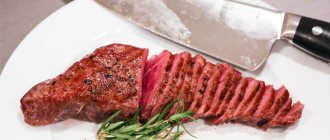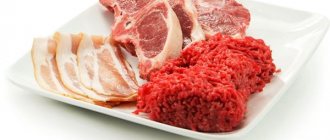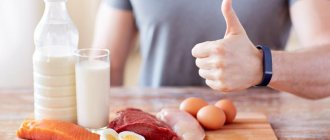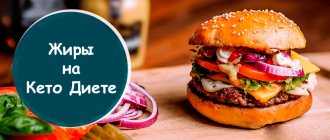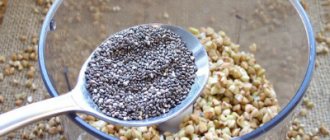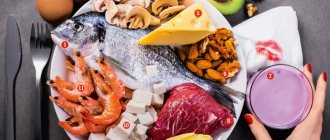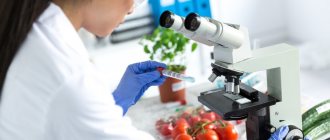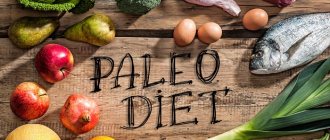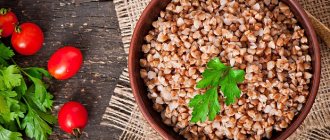General rules
One type of low-carbohydrate diet program is the ketosis (ketogenic) diet .
The goal of such a diet is to achieve a metabolic called ketosis , which is a metabolic process in which the key physiological process for providing energy to the body in the body is the process of burning fat. Initiated by the body when there is a deficiency of carbohydrates.
With a standard diet, when the level of glucose in the body is sufficient, the main source of energy is glycogen , which is formed during the digestion of various types of carbohydrates. But when the glycogen supply is critically low, which occurs with a low-carbohydrate diet, the body, through special biochemical mechanisms, launches an alternative ketogenic program for obtaining energy.
An average-weight adult has energy reserves in the form of glycogen of about 1300-1600 kcal. Then the process of gluconeogenesis , during which protein, lactate , glycerol , and pyruvate are broken down into glucose . During this period, the body uses protein more intensively than fat, which often leads to a decrease in the mass of internal organs and muscles. Further, if there is insufficient carbohydrate intake, the ketosis mechanism is activated.
This process is launched by the release of hormones that initiate the process of ketosis, during which active breakdown of fats occurs with the formation of fatty acids and ketone bodies, which, entering the bloodstream and being utilized, become a new and main source of energy nutrition for all organs and tissues of the body. As a rule, the ketosis mechanism is triggered when the carbohydrate content in the daily diet is 100 g/day. Usually, on the 6-8th day of such nutrition, the body completely switches to lipolysis (the use of fats as the main source of energy). At the same time, the rate of onset of ketosis is largely determined by the level of physical activity.
With high daily physical activity, the process of ketosis can begin on the 2-3rd day of such nutrition; with a passive lifestyle, its onset can take up to 7-9 days. The process of ketosis is multi-stage and occurs in the liver with the formation of a number of intermediate substances. Thus, the ketogenic diet, in essence, aims to change metabolic processes in the direction of increasing the synthesis of ketones.
Ketogenic diet for epilepsy in adults and children
The ketosis diet is widely used for medicinal purposes for epilepsy in children and adults. As practice shows, such nutrition can significantly improve control over the frequency and duration of epileptic seizures and increase the periods between them, especially in children in cases of drug-resistant epilepsy.
The main mechanism of treatment is the effect of specific metabolic products (ketone bodies) on brain structures, which ensures the anticonvulsant effect. Research has shown that under the influence of ketones, the production of free radicals is reduced, the process of destruction of brain cells is inhibited, the production of antioxidants that protect the brain is increased, and the accumulation of amyloid plaques, which cause neurodegenerative changes in brain structures, is reduced.
In general, for epilepsy (partial and generalized forms), as well as for conditions such as Dravet syndrome , infantile spasms , Duse syndrome , tuberous sclerosis in cases where there are no metabolic disorders, the ketogenic diet is considered as one of the alternative non-drug treatment options drug-resistant epilepsy. The effectiveness of the method is especially high in young children.
The phenomenon of dietary ketosis is also extremely widely used in special nutrition programs, the purpose of which is to activate the fat burning process while maintaining muscle mass, optimizing strength and endurance parameters. This type of nutrition is used primarily in the practice of athletes involved in strength sports and bodybuilding.
Basic principles of the ketosis diet
- Changing the diet in the direction of reducing the carbohydrate content to 40-50 g per day with a physiologically normal content of proteins and fats, the ratio of which should initially be 1: 1, and later, after the body goes through a “metabolic shift”: 60-70% in The diet should consist of fats, 20-30% proteins and carbohydrates, no more than 50 g. Almost all carbohydrate-containing foods (porridge, almost all fruits, vegetables, sweets, legumes, flour, alcohol) are excluded.
- Changes in the energy value of the diet. If the goal is to lose weight, then the caloric content of the diet should be 500 kcal less than the norm. If the goal of the diet is to gain muscle mass, then the calorie content of the diet should be 500 kcal higher than normal. However, these indicators vary significantly depending on the body's energy consumption and metabolic rate.
- Reduces table salt consumption.
- The consumption of free liquid increases to 3 or more liters/day (at the rate of 40 ml per 1 kg of weight).
- “Carbohydrate loading” is practiced once a week (this is the most common version of the diet).
- The number of meals is at least 5. At the same time, the interval between them should not exceed 3-4 hours. The last meal is no later than 3 hours before bedtime.
Fat/Protein/Carb Ratio for Keto Diet
Signs of the development of ketosis are:
- ketones in urine , which can be checked with special test strips.
- Decreased appetite.
- Increased energy, improved mood, increased strength and vigor.
- The smell of acetone may appear from the mouth (sweat, urine) .
The correct selection of a ketogenic diet largely determines the speed of achieving your goals.
How to calculate your daily macronutrient intake
For each person, BJU indicators during a diet vary. You need to calculate them yourself before starting the diet.
Protein
The general formula is as follows: for every kilogram of lean body mass - 1 gram of protein. All protein should be distributed equally between meals.
To determine muscle mass you need:
- Determine your body fat percentage;
- Multiply your weight in kilograms by your body fat percentage to get your fat weight in kilograms;
- Subtract the resulting number from the total mass of the entire body - this is muscle mass.
To find out your body fat percentage, you can use:
- scales with bioimpedance analysis;
- compare your photo in underwear with photos of other people with different percentages of body fat on special websites on the Internet;
- caliper - a device that measures the thickness of the skin fold;
Caliper
- electrical impedance myography (sculpt scanner);
- Bod Pod - air displacement plethysmography;
- dual-energy X-ray absorptiometry.
To successfully complete the diet, it is important to take measurements as accurately as possible. You can’t make a rough estimate by eye - this will prevent the body from adapting to fat burning.
Carbohydrates
Let us clarify that we are talking about pure carbohydrates, those that will be completely absorbed. To calculate them, subtract the weight of dietary fiber in grams from the total amount of all carbohydrates.
The total daily intake of digestible carbohydrates should be increased to 50 (or less) grams per day. This is approximately 10% of your daily caloric intake. But the exact number for your body may be much less, up to 10 – 15 grams per day. It all depends on the individual characteristics of the body and concomitant diseases.
Usually, when entering a state of ketosis, it is necessary to greatly reduce the intake of carbohydrates (focus on 20 grams), and then you can experiment and increase this figure (up to 40, or even 80 grams, if you have high loads).
Important! If you overdo it with carbohydrates, you won’t be able to “fly” out of nutritional ketosis for long.
Fats
Important! The amount of omega-6 fatty acids should not exceed 4% of the daily calorie intake.
Fats are the basis of the diet; their daily intake should be 70–85%.
If you have problems digesting fats, start taking digestive enzymes with lipase.
Varieties
There are several types of keto diets. When determining the right option, you should always take into account the priority tasks for a particular case and person (for losing weight, for building muscle mass, drying the body), however, in practice, the choice of diet is often chaotic.
The most popular types of diet are:
Classic (standard, basic) type of diet
This option does not include periods of carbohydrate loading. This diet maintains a constant level of macronutrients (high/moderate protein , high fat, and extremely low carbohydrate).
The standard diet is recommended for people who do not lead a very active lifestyle, and the training regimen is of low intensity. Reducing the carbohydrate content in the diet will not significantly affect their performance.
Cyclical type of diet
A cyclical diet involves alternating low-carbohydrate and high-carbohydrate periods in the diet with one fasting day per week. glycogen is replenished in muscle tissue. The time intervals between such periods and their duration are selected individually depending on the goals and sports regime, and can also change depending on the state of the body and general well-being.
It is important to understand that during the period of loading the body with carbohydrates, it is necessary to limit the consumption of fats with a constant or even slightly increased protein content, if there is a need to maintain the overall calorie content of the diet. The cyclical type of ketogenic diet is indicated for those people who lead an intense lifestyle and practice high physical activity, and feel weak when there is insufficient carbohydrate content in the diet. In such cases, carbohydrate periods replenish the body's depleted reserves, allowing you to maintain your lifestyle and training intensity at the required level.
Targeted type of keto diet
In this option, special attention is paid to the amount of carbohydrates taken before and after training. To do this, over a certain period of time on a diet, it is necessary to evaluate the body’s reaction to different amounts of carbohydrates taken and determine the best time to take them. The task of this period is to determine the optimal amount of carbohydrates and their level of content, ensuring the necessary performance of the body.
The targeted diet involves increased intake of carbohydrates on training days (during the training window) before and after exercise. On other days, the amount of carbohydrates in the diet corresponds to the calculations for a standard type of diet. In this case, carbohydrate intake provides the body with energy while maintaining a state of ketosis . That is, unlike a cyclical diet, which provides periods for replenishing glycogen stores, a targeted diet is aimed at maintaining glycogen stores at an optimal level.
And it is also very important not to forget that in “near-training” meals it is necessary to reduce the proportion of fats.
Select an option
In order to decide what type of diet is right for you, in addition to the goal being pursued, you should monitor the state of your body in the process of following it (changes in well-being, physical activity). Initially, it is recommended to build your diet for 1-2 weeks on the basis of a standard diet, and then, having determined how beneficial such nutrition is for your vital activity and body parameters, you can move on to a diet for a longer period or to other types of diet.
It is important to realize that the overall energy content of the diet is of primary importance, regardless of the type of diet being practiced. However, it is generally accepted that the classic type of ketogenic diet is more suitable for those who want to lose weight, and cyclical and targeted diet options are optimal for building (shrinking) muscle mass.
According to well-known experts, for example, Denis Borisov, the cyclic type of ketogenic diet is the most optimal for the vast majority. The targeted type of ketogenic diet is suitable for those who are already quite active, have been training hard for a long time, and for them a small intake of carbohydrates is more beneficial than their long-term restriction.
macronutrients in your diet in a special way . There are special instructions for this, which can be found on many web resources on the Internet.
Things to consider before starting a diet
As with any lifestyle change, you need to get into the right mindset and plan your journey. If you don't plan your weight loss goals, your chances of success will drop dramatically. You don't want to be the average person who "says" they will change, you want to be the person who actually does it.
Here are 6 tips to follow before committing to the keto diet:
- It is in your best interest to see a professional (doctor and/or nutritionist) before starting this diet to a) have your blood tested to make sure you don't have any underlying medical conditions, and b) make sure you have enough knowledge to so that you can start eating right, and not just throw away foods that you consider harmful and eat very little.
- Get rid of all foods that are not included in the keto diet. Search your refrigerator, pantry, cupboards and either donate or throw away any foods that are not keto-friendly.
- Learn how to read food labels. Find out what macronutrients are and how to count them. It is necessary to learn the basics before starting a ketogenic diet.
- Gradually reduce your sugar and carbohydrate intake. Your transition into ketosis will be much smoother if you gradually reduce your carb intake rather than jumping right into it. The likelihood of dealing with the “keto flu” will decrease, and you will become more comfortable in the initial stages of your transition to full keto.
- Drink plenty to help your body adapt smoothly.
- Learn how to measure ketone levels. It would be in your best interest to study the levels of ketosis in your diet so that you know how to troubleshoot any future problems.
Authorized Products
The diet is formed mainly by red meat in any culinary preparation, poultry (chicken, turkey), rabbit, fatty varieties of river and sea fish (tuna, salmon, herring), seafood, egg whites, vegetable oils (corn, olive, sunflower ).
The diet should contain hard cheese, butter, cottage cheese, sour cream and other high-fat dairy products, green vegetables, high in organic fiber.
Vegetables in the diet should include cauliflower, broccoli, Chinese and white cabbage, celery stalks, zucchini, cucumbers, green salad leaves, green beans, and onions.
It is also allowed to include walnuts and other nuts, peanuts, flax seeds, and olives in the diet.
Table of permitted products
| Proteins, g | Fats, g | Carbohydrates, g | Calories, kcal | |
Vegetables and greens | ||||
| green peas | 5,0 | 0,2 | 13,8 | 73 |
| zucchini | 0,6 | 0,3 | 4,6 | 24 |
| Brussels sprouts | 4,8 | 0,0 | 8,0 | 43 |
| cabbage | 1,2 | 0,2 | 2,0 | 16 |
| cauliflower | 2,5 | 0,3 | 5,4 | 30 |
| cucumbers | 0,8 | 0,1 | 2,8 | 15 |
| olives | 0,8 | 10,7 | 6,3 | 115 |
| iceberg lettuce | 0,9 | 0,1 | 1,8 | 14 |
| celery | 0,9 | 0,1 | 2,1 | 12 |
| green beans | 2,8 | 0,4 | 8,4 | 47 |
Mushrooms | ||||
| mushrooms | 3,5 | 2,0 | 2,5 | 30 |
Nuts and dried fruits | ||||
| nuts | 15,0 | 40,0 | 20,0 | 500 |
| peanut | 26,3 | 45,2 | 9,9 | 551 |
| flax seeds | 18,3 | 42,2 | 28,9 | 534 |
Cereals and porridges | ||||
| brown rice | 7,4 | 1,8 | 72,9 | 337 |
Raw materials and seasonings | ||||
| mayonnaise | 2,4 | 67,0 | 3,9 | 627 |
Dairy | ||||
| milk 3.2% | 2,9 | 3,2 | 4,7 | 59 |
| kefir 3.2% | 2,8 | 3,2 | 4,1 | 56 |
| cream 20% (medium fat content) | 2,8 | 20,0 | 3,7 | 205 |
| sour cream 25% (classic) | 2,6 | 25,0 | 2,5 | 248 |
| Ryazhenka | 2,8 | 4,0 | 4,2 | 67 |
Meat products | ||||
| pork | 16,0 | 21,6 | 0,0 | 259 |
| salo | 2,4 | 89,0 | 0,0 | 797 |
| boiled beef | 25,8 | 16,8 | 0,0 | 254 |
| boiled veal | 30,7 | 0,9 | 0,0 | 131 |
| rabbit | 21,0 | 8,0 | 0,0 | 156 |
| bacon | 23,0 | 45,0 | 0,0 | 500 |
| ham | 22,6 | 20,9 | 0,0 | 279 |
Sausages | ||||
| dry-cured sausage | 24,1 | 38,3 | 1,0 | 455 |
| smoked sausage | 9,9 | 63,2 | 0,3 | 608 |
| sausages | 10,1 | 31,6 | 1,9 | 332 |
| sausages | 12,3 | 25,3 | 0,0 | 277 |
Bird | ||||
| boiled chicken | 25,2 | 7,4 | 0,0 | 170 |
| turkey | 19,2 | 0,7 | 0,0 | 84 |
| duck | 16,5 | 61,2 | 0,0 | 346 |
| goose | 16,1 | 33,3 | 0,0 | 364 |
Eggs | ||||
| soft-boiled chicken eggs | 12,8 | 11,6 | 0,8 | 159 |
Fish and seafood | ||||
| pink salmon | 20,5 | 6,5 | 0,0 | 142 |
| Red caviar | 32,0 | 15,0 | 0,0 | 263 |
| salmon | 19,8 | 6,3 | 0,0 | 142 |
| seafood | 15,5 | 1,0 | 0,1 | 85 |
| sturgeon | 16,4 | 10,9 | 0,0 | 163 |
| herring | 16,3 | 10,7 | — | 161 |
| cod (liver in oil) | 4,2 | 65,7 | 1,2 | 613 |
| tuna | 23,0 | 1,0 | — | 101 |
| acne | 14,5 | 30,5 | — | 332 |
| sprats | 17,4 | 32,4 | 0,4 | 363 |
Oils and fats | ||||
| vegetable oil | 0,0 | 99,0 | 0,0 | 899 |
| butter | 0,5 | 82,5 | 0,8 | 748 |
| linseed oil | 0,0 | 99,8 | 0,0 | 898 |
| animal fat | 0,0 | 99,7 | 0,0 | 897 |
| cooking fat | 0,0 | 99,7 | 0,0 | 897 |
Non-alcoholic drinks | ||||
| mineral water | 0,0 | 0,0 | 0,0 | — |
| green tea | 0,0 | 0,0 | 0,0 | — |
| black tea | 20,0 | 5,1 | 6,9 | 152 |
| * data is per 100 g of product | ||||
Increased Energy
When losing weight, most people suffer from apathy, depression, and loss of strength. This is due to low blood glucose levels. This will not happen with the keto approach. Simple recipes provide a long-lasting feeling of fullness, with a fairly high level of energy.
To increase energy, it is better to combine nutrition with physical activity. During training, vital hormones are released, which, in combination with a low-carbohydrate diet, will give incredible results.
Fully or partially limited products
The list of keto diet foods prohibited for consumption includes sugar, baked goods, cookies, waffles, ice cream, candies, chocolate, preserves, jams, various dried fruits, starch, powdered drinks, bran, seeds, carbonated drinks, sorbitol and fructose products .
It is prohibited to include in the diet any cereals, pasta, any type of bread, crackers, carrots, potatoes, beets and other starchy vegetables, sweet dairy products, juices, melon, bananas, grapes, fruits, beer, honey, caffeine-containing products.
Table of prohibited products
| Proteins, g | Fats, g | Carbohydrates, g | Calories, kcal | |
Vegetables and greens | ||||
| potato | 2,0 | 0,4 | 18,1 | 80 |
| carrot | 1,3 | 0,1 | 6,9 | 32 |
| radish | 1,2 | 0,1 | 3,4 | 19 |
| turnip | 1,5 | 0,1 | 6,2 | 30 |
| beet | 1,5 | 0,1 | 8,8 | 40 |
Berries | ||||
| grape | 0,6 | 0,2 | 16,8 | 65 |
Cereals and porridges | ||||
| semolina | 10,3 | 1,0 | 73,3 | 328 |
| pearl barley | 9,3 | 1,1 | 73,7 | 320 |
| Wheat groats | 11,5 | 1,3 | 62,0 | 316 |
| millet cereal | 11,5 | 3,3 | 69,3 | 348 |
| white rice | 6,7 | 0,7 | 78,9 | 344 |
Flour and pasta | ||||
| pasta | 10,4 | 1,1 | 69,7 | 337 |
| spaghetti | 10,4 | 1,1 | 71,5 | 344 |
| pancakes | 6,1 | 12,3 | 26,0 | 233 |
| vareniki | 7,6 | 2,3 | 18,7 | 155 |
| dumplings | 11,9 | 12,4 | 29,0 | 275 |
Bakery products | ||||
| vysivkovy bread | 9,0 | 2,2 | 36,0 | 217 |
| Rye bread | 6,6 | 1,2 | 34,2 | 165 |
Confectionery | ||||
| jam | 0,3 | 0,2 | 63,0 | 263 |
| jam | 0,3 | 0,1 | 56,0 | 238 |
| candies | 4,3 | 19,8 | 67,5 | 453 |
| cookie | 7,5 | 11,8 | 74,9 | 417 |
| crackers with raisins | 8,4 | 4,9 | 78,5 | 395 |
| dough | 7,9 | 1,4 | 50,6 | 234 |
Ice cream | ||||
| ice cream | 3,7 | 6,9 | 22,1 | 189 |
Cakes | ||||
| cake | 4,4 | 23,4 | 45,2 | 407 |
Chocolate | ||||
| chocolate | 5,4 | 35,3 | 56,5 | 544 |
Raw materials and seasonings | ||||
| honey | 0,8 | 0,0 | 81,5 | 329 |
Dairy | ||||
| condensed milk | 7,2 | 8,5 | 56,0 | 320 |
| fruit yogurt 3.2% | 5,0 | 3,2 | 8,5 | 85 |
Alcoholic drinks | ||||
| liquor | 0,3 | 1,1 | 17,2 | 242 |
| beer | 0,3 | 0,0 | 4,6 | 42 |
| cider | 0,2 | 0,3 | 28,9 | 117 |
Non-alcoholic drinks | ||||
| cola | 0,0 | 0,0 | 10,4 | 42 |
| coffee with milk and sugar | 0,7 | 1,0 | 11,2 | 58 |
| Pepsi | 0,0 | 0,0 | 8,7 | 38 |
| energy drink | 0,0 | 0,0 | 11,3 | 45 |
Juices and compotes | ||||
| compote | 0,5 | 0,0 | 19,5 | 81 |
| grape juice | 0,3 | 0,0 | 14,0 | 54 |
| pear juice | 0,4 | 0,3 | 11,0 | 46 |
| jelly | 0,2 | 0,0 | 16,7 | 68 |
| raspberry juice | 0,8 | 0,0 | 24,7 | 100 |
| * data is per 100 g of product | ||||
Improved mental function
Ketone bodies are a source of energy for the brain. Reducing simple carbohydrates in the daily diet leads to normalization of blood sugar levels. As a result, there are no surges, loss of strength, or decrease in energy. The body works stably, focus and concentration appear. That is why the keto diet is used for the elderly and acts as a preventative measure for Parkinson’s and Alzheimer’s disease.
Recipes for every day can be found on the Internet. To improve brain activity, emphasis should be placed on healthy fats - nuts, oils.
Some experts recommend additional egg fasting on keto. What it is? A temporary solution designed to “zero out” the amount of carbohydrates. You need to eat 6-10 eggs a day, adding the same number of tablespoons of oil to them. This will be a jolt for the body and will speed up the process of losing weight. But you cannot fast for more than five days.
Keto diet menu (Meal mode)
With any type of keto diet, it is important to be able to independently create a menu for the day/week.
Red meat and green beans are the perfect food package
An approximate algorithm for this process is given below:
- Determine your daily energy requirement in calories, depending on your goal - losing weight, gaining muscle mass or burning fat while maintaining weight. Take, for example, a standard type of keto diet with a 2000 kcal diet and a person weighing 75 kg.
- The protein consumption rate is 2 g of dry mass per kg of weight. That is, the protein content in the daily diet should be 75 * 2 = 150 g.
- The specified amount of carbohydrates is 30 g/day at the rate of 0.40 g/kg.
- We calculate the calorie content of the protein-carbohydrate component of the diet. It is known that the calorie content of one gram of proteins and carbohydrates is 4 kcal. We do the calculation (150 + 30) * 4 = 720 kcal. That is, due to these nutrients we provide the body with 720 kcal.
- We calculate the required amount of fat in the diet: to do this, subtract 720 from the total calorie content of the diet (2000). We get 1280 kcal. The calorie content of one gram of fat is 9 kcal. Next, we divide the missing amount of energy by 9. Thus, the daily amount of fat in the diet should be 142 g.
- Next, taking into account the amount of necessary macronutrients and the ratio of proteins and fats, we divide by the number of meals. For example, with five meals a day, one meal will contain 30 g of protein, 5 g of carbohydrates, and 28-29 g of fat. Don't forget that the protein/fat ratio is calculated for the whole day, not for one meal.
- Select the products you need from the list of allowed ones and calculate the nutrient content in 100 g of each of them (according to special tables) and create your menu for the week.
Keto diet, menu for the week (approximate version)
The basis is a ketone diet for weight loss, in which the caloric content of the daily diet is reduced by 500 kcal relative to the norm.
Monday
| Breakfast |
|
| Lunch |
|
| Dinner |
|
| Afternoon snack |
|
| Dinner |
|
| For the night |
|
Tuesday
| Breakfast |
|
| Lunch |
|
| Dinner |
|
| Afternoon snack |
|
| Dinner |
|
| For the night |
|
Wednesday
| Breakfast |
|
| Lunch |
|
| Dinner |
|
| Afternoon snack |
|
| Dinner |
|
| For the night |
|
Thursday
| Breakfast |
|
| Lunch |
|
| Dinner |
|
| Afternoon snack |
|
| Dinner |
|
| For the night |
|
Friday
| Breakfast |
|
| Lunch |
|
| Dinner |
|
| Afternoon snack |
|
| Dinner |
|
| For the night |
|
Saturday
| Breakfast |
|
| Lunch |
|
| Dinner |
|
| Afternoon snack |
|
| Dinner |
|
| For the night |
|
Sunday
| Breakfast |
|
| Lunch |
|
| Dinner |
|
| Afternoon snack |
|
| Dinner |
|
| For the night |
|
If you are calculating a ketogenic diet menu for cutting , then for this purpose a cyclic type of diet is used, the diet of which corresponds to the above, however, on Wednesday, a 36-hour carbohydrate load is practiced.
Its main goal is to increase muscle glycogen stores to support intense workouts. To do this, start including carbohydrates with a high glycemic index , and then move on to foods that have a lower glycemic index.
Recipes
An important advantage: the keto diet combines food recipes so that hunger will not be disturbed during weight loss, maintaining a state of ketosis, and the above allowed products are affordable.
Keto - bread
Recipe No. 1
Almond flour contains 54.5 grams of fat per 100 g of product, which makes the ingredient suitable for a keto diet.
Cooking method:
- Mix all dry ingredients in a bowl.
- Pour in hot water, lightly beaten egg whites and vinegar. Beat with a mixer until you get a sticky dough.
- With wet hands, form several pieces of future bread.
- Grease a baking dish with olive oil and lay out the dough.
- Place in an oven preheated to 180 degrees for 45-50 minutes. Readiness to determine with a toothpick.
– almond flour – 250 g; – crushed plantain leaves – 5 tbsp; - baking powder - 2 tsp; – sea salt – 1 tsp; - apple cider vinegar - 2 tsp; – hot water – 200 ml; — egg white – 3 pcs.; – sesame – 30 g.
Salmon baked with asparagus
Recipe No. 2
Salmon meat contains from 7 to 12 g of protein, depending on the variety. The tender and rich taste of meat combined with asparagus will be an ideal option for serving the dish for dinner.
Cooking method:
- Marinade: mix soy sauce, sesame oil, chopped basil and crushed garlic.
- Cut the fillet into small pieces or into steaks, place in a sealed bag and pour over the marinade. Place in the refrigerator for 1 hour.
- Cover a baking dish with foil, lay out the marinated fish with the remaining sauce, and lay out the washed asparagus. Close the foil tightly.
- Place in an oven preheated to 180 degrees for 20 minutes.
- In a hot frying pan, fry diced onions and mushrooms in butter.
- Open the foil, spread the fry evenly over the fish, and bake for another 10 minutes.
Ingredients: - salmon fillet - 1 kg; – asparagus – 150 g; – mushrooms – 200 g; - onion - 40 g; - garlic - 3 cloves; — soy sauce – 300 ml; – sesame oil – 10 ml; — butter – 20 g; - basil - 3 sprigs.
Chicken casserole with cheese and olives
Recipe No. 3
Cooking method:
- Wash the meat, dry it and cut it into small pieces, add salt.
- Fry in butter on both sides until golden.
- Mix cream and pesto sauce.
- Cut the cheese into small cubes, chop the garlic, cut the olives into rings.
- Place the chicken in a baking dish, distribute olives, cheese, and garlic evenly on top. Pour over cream sauce.
- Place in an oven preheated to 200 degrees for 30 minutes.
Ingredients: - chicken thighs fillet - 350 g; — chicken breast fillet – 350 g; – high fat cream – 400 ml; — feta cheese – 250 g; — pesto sauce – 90 g; — pitted olives – 200 g; - garlic - 1 clove; – olive oil – 40 ml; - butter (for frying) - 10 g; - greens, salt - to taste.
Comments from nutritionists
Considering that the emphasis of the keto diet is on protein and fatty foods, with an extremely low fiber content, digestive disorders may appear - bloating and heaviness in the stomach, constipation .
Removing carbohydrates and fiber from the menu provokes the development and colonization of the intestines by pathogenic microorganisms, which contributes to the development of dysbiosis and decreased immunity . To avoid such problems, it is recommended to consume at least minimal quantities of some vegetables and fruits (cabbage, apples, sour grapes).
The big disadvantage of the keto diet is glucose deficiency and the unpredictability of the body's reaction to this condition. Physical activity that is inadequate to the state of the body can provoke hypoglycemia , manifested by dizziness , general weakness, drowsiness , and nausea . Monitor your health carefully and consult a doctor when the first signs appear.
To prevent hypoglycemia, we recommend snacking on juices and semi-sweet fruits, and when the first signs of hypoglycemia , introduce tea with a small amount of honey into your diet. Glucose deficiency also affects the quality and activity and performance of the brain, especially cognitive functions (attention, concentration, memory) suffer. After reaching the ketosis phase, they are partially restored, but still remain at a level lower than with the normal carbohydrate content in the diet. Therefore, the keto diet is undesirable during intense mental work during sessions.
With a long-term ketogenic diet, side effects may occur such as the formation of kidney stones , dehydration, increased blood cholesterol constipation . Eating this way can also trigger a gout .
Since such a diet does not provide the body with all the necessary vitamins and minerals, it is recommended to take complex preparations containing a wide range of water/fat-soluble vitamins and minerals.
Be sure to consult with your doctor before starting the keto diet.
Carbohydrate window
Some might think that this is all about closing the carb window, meaning eating a bunch of simple carbs right after your workout and then returning to your regular low-carb diet throughout the day.
But it is important to remember that muscle protein synthesis is increased for 36-48 hours after exercise. And the restoration of glycogen can take from a day to several days. Accordingly, the sensitivity of muscle cells to insulin may be increased for several days.
Post-workout muscle recovery and growth isn't just about what you do immediately after your workout, but what you eat throughout the days between workouts. All food plays a role. Read more about the protein-carbohydrate window here.
Keto diet, reviews and results
Despite the fairly high effectiveness of such nutrition, reviews of the ketogenic diet for weight loss vary significantly. The forum dedicated to this topic is full of positive and negative reviews.
- “... I’ve been doing bodybuilding for almost a year. Following the example of friends, I began to practice the ketone diet. But for some reason, from the very first days, I not only felt weak, I simply could not lead my usual lifestyle (I am a student), and I did not notice any special results before and after the keto diet. I tried all its options until I realized that this diet was not for me and I didn’t need to force my body like that. In the end, I work out for health and to maintain my normal figure, and not to prepare for the World Championships”;
- “... I practice the keto diet regularly, but as a rule, no more than 2-3 weeks. I use it for final polishing of muscle relief after gaining muscle mass. The diet is fit for purpose.”
Contraindications
Despite the benefits, the keto diet has contraindications:
- pregnancy, breastfeeding period;
- high cholesterol;
- diabetes;
- diseases of the gastrointestinal tract, heart, kidneys;
- difficulty digesting fatty foods;
- malfunction of the thyroid gland;
- porphyria.
Improved cardiovascular function
A sufficient amount of protein and healthy fats in the diet ensures a decrease in the level of “bad” cholesterol and stabilization of blood pressure. This helps reduce the likelihood of blood clots and plaques forming. Experts note that it strengthens the walls of blood vessels and improves blood quality.
The main thing is to get tested regularly to identify deficiencies of vitamins, minerals, and nutrients. This approach will be the key to maintaining health, which is especially important when losing weight.
But the disadvantages largely outweigh the advantages. This is evidenced by the materials of the XXVI European Congress on the Study of Obesity, held in Glasgow, Scotland.
